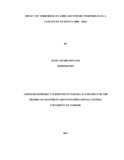| dc.description.abstract | The 21st century is one characterized by more connectivity than at any other point in human history. Advancements in transport and communication over millennia has made human existence so interconnected and interdependent that it‗s no longer possible to conceive the word as made up of non-interacting units and systems. The overall objective of this study was to assess the effect of terrorism on Economic Performance. This study will be guided by New Growth Theory. Endogenous growth or the new growth theory emerged in the 1990s to explain the poor performance of many less developed countries, which have implemented policies as prescribed in neoclassical theories. This study consisted of qualitative research and analysis although quantitative data was used to support the analysis in some instances. The focus of this study was Nairobi County in Kenya. The target population mainly comprised of people in the hotel industry, Tours and Safaris, curio and souvenir traders, shopping mall owners, as well small business people. The study got reliable information from Kenya Bureau of statistics. It reviewed past reports on terrorism acts and their impact on Economic Performance of the country. Purposive sampling was used to collect data from 300 managers of hotel industry, Tours and Safaris, curio and souvenir traders, shopping mall owners, as well business people in Nairobi. The study collected both primary and secondary data. Primary data was collected by use of semi- structured questionnaire. Analysis of recorded information/documents was also done in order to obtain information that informants gave thought to while compiling, and also information in their own words. The study also involved an evaluation of secondary data sources from Kenya national bureau of statistics; this served to strengthen the overall study. Simple statistical methods were applied such as means, percentages and other statistical techniques. These were supported by secondary data from published sources and observations which boosted the credibility and validity of the information. Both qualitative and quantitative data analysis methods were used. The data was organized with significant patterns to reveal the essence of the data. Once collected, the data was computed using SPSS and MS Excel for analysis with an aim of achieving a complete picture on data collected and so that the research questions could be answered. According to the findings corruption and terrorism do not only join forces in conflict-affected countries where criminal activities are likely to flourish. Corruption and poor governance hamper countries‘ ability to fight terrorism, Corruption facilitates international terror attacks, Corruption helps cross-border terrorist financing and Corruption and terrorist financing share methods to hide money. The study concludes that Kenya has experienced many acts of terrorism. These acts have greatly affected the economic growth causing Kenya to rely heavily on international different sectors of economy in the past. Consequently, the majority of the industries suffered a great blow. It is recommended that while the government has taken several preventive measures, it is still necessary for the Kenya government to develop a crisis management strategy in order to reduce the aftermath of such horrendous acts in the future. | en_US |



